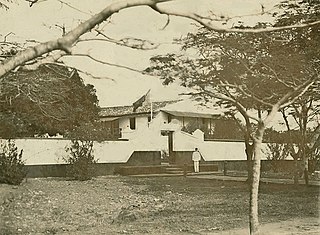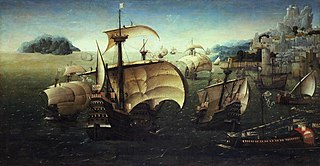Related Research Articles
The Armed Forces of São Tomé and Príncipe are the armed forces of the island nation of São Tomé and Príncipe, off the coast of West Africa. The islands' military consists of a small land and naval contingent, with a limited budget. Sitting adjacent to strategically important sea lane of communication in the Gulf of Guinea, due to recent concerns about regional security issues including security for oil tankers transiting the area, the US military and other foreign navies have increased their engagement with the FASTP, providing the country with assistance in the form of construction projects and training missions, as well as integration into international information and intelligence sharing programs.

Bartolomeu Dias was a Portuguese mariner and explorer. In 1488, he became the first European navigator to round the southern tip of Africa and to demonstrate that the most effective southward route for ships lies in the open ocean, well to the west of the African coast. His discoveries effectively established the sea route between Europe and Asia.

The recorded history of Cape Verde begins with the Portuguese discovery of the island in 1458. Possible early references to Cape Verde date back at least 2,000 years.

The Darien scheme was an unsuccessful attempt, backed largely by investors of the Kingdom of Scotland, to gain wealth and influence by establishing New Caledonia, a colony in the Darién Gap on the Isthmus of Panama, in the late 1690s. The plan was for the colony, located on the Gulf of Darién, to establish and manage an overland route to connect the Pacific and Atlantic Oceans. The backers knew that the first sighting of the Pacific Ocean by Vasco Núñez de Balboa was after crossing the isthmus through Darién. The expedition also claimed sovereignty over "Crab Isle" in 1698, yet sovereignty was short-lived. The attempt at settling the area did not go well; more than 80 percent of participants died within a year, and the settlement was abandoned twice.

The Middle Passage was the stage of the Atlantic slave trade in which millions of enslaved Africans were transported to the Americas as part of the triangular slave trade. Ships departed Europe for African markets with manufactured goods, which were then traded for slaves with rulers of African states and other African slave traders. Slave ships transported the slaves across the Atlantic. The proceeds from selling slaves were then used to buy products such as furs and hides, tobacco, sugar, rum, and raw materials, which would be transported back to Europe to complete the triangle.

Elmina Castle was erected by the Portuguese in 1482 as Castelo de São Jorge da Mina, also known as Castelo da Mina or simply Mina, in present-day Elmina, Ghana, formerly the Gold Coast. It was the first trading post built on the Gulf of Guinea, and the oldest European building in existence south of the Sahara.

The Forte de São João Baptista de Ajudá is a small restored fort in Ouidah, Benin. Built in 1721, it was the last of three European forts built in that town to tap the slave trade of the Slave Coast. Following the legal abolition of the slave trade early in the 19th century, the Portuguese fort lay abandoned most of the time until it was permanently reoccupied in 1865.

The Portuguese Gold Coast was a Portuguese colony on the West African Gold Coast along the Gulf of Guinea. Established in 1482, the colony was officially incorporated into Dutch territory in 1642. From their seat of power at the fortress of São Jorge da Mina, the Portuguese commanded a vast internal slave trade, creating a slave network that would expand after the end of Portuguese colonialism in the region. The primary export of the colony was gold, which was obtained through barter with the local population. Portuguese presence along the Gold Coast increased seamanship and trade in the Gulf, introduced American crops into the African agricultural landscape, and made Portuguese an enduring language of trade in the area.

The Dutch–Portuguese War was a global armed conflict involving Dutch forces, in the form of the Dutch East India Company, the Dutch West India Company, and their allies, against the Iberian Union, and after 1640, the Portuguese Empire. Beginning in 1598, the conflict primarily involved the Dutch companies and fleet invading Portuguese colonies in the Americas, Africa, and the East Indies. The war can be thought of as an extension of the Eighty Years' War being fought in Europe at the time between Spain and the Netherlands, as Portugal was in a dynastic union with Spain after the War of the Portuguese Succession, for most of the conflict. However, the conflict had little to do with the war in Europe and served mainly as a way for the Dutch to gain an overseas empire and control trade at the cost of the Portuguese.

Portuguese maritime exploration resulted in the numerous territories and maritime routes recorded by the Portuguese as a result of their intensive maritime journeys during the 15th and 16th centuries. Portuguese sailors were at the vanguard of European exploration, chronicling and mapping the coasts of Africa and Asia, then known as the East Indies, and Canada and Brazil, in what came to be known as the Age of Discovery.
Quedagh Merchant, also known as the Cara Merchant and the Adventure Prize, was an Armenian merchant vessel famously captured by Scottish privateer William Kidd on 30 January 1698.

São Tomé and Príncipe, officially the Democratic Republic of São Tomé and Príncipe, is an island country in the Gulf of Guinea, off the western equatorial coast of Central Africa. It consists of two archipelagos around the two main islands of São Tomé and Príncipe, about 150 km (93.21 mi) apart and about 250 and 225 km off the northwestern coast of Gabon. With a population of 201,800, São Tomé and Príncipe is the second-smallest and second-least populous African sovereign state after Seychelles.

The Portuguese Indian Armadas were the fleets of ships funded by the Crown of Portugal, and dispatched on an annual basis from Portugal to India. The principal destination was Goa, and previously Cochin. These armadas undertook the Carreira da Índia from Portugal, following the maritime discovery of the Cape route, to the Indian subcontinent by Vasco da Gama in 1497–99.

Cape Verde was a colony of the Portuguese Empire from the initial settlement of the Cape Verde Islands in 1462 until the independence of Cape Verde in 1975.
João de Sá, knight was a Portuguese explorer, who accompanied Vasco da Gama on the voyage of the first ships to sail directly from Europe to India.

São Tomé and Príncipe islands were a colony of the Portuguese Empire from their discovery in 1470 until 1975, when independence was granted by Portugal.

The São José Paquete Africa was a slave ship from the Kingdom of Portugal that sank in 1794 off the coast of Cape Town, South Africa. Close to shore, but in deep water, 212 of the 400 to 500 African slaves who were aboard died when the ship sank. In 2015, the Smithsonian's African American History Museum, South Africa's Iziko Museums, the Slave Wrecks Project, and other partners, confirmed discovery of the wreck near where it sank. The ship and its slaves were headed from Portuguese Mozambique to Colonial Brazil, during the height of the international African slave trade. Few other former slave ships have been found, but the São José is the first and only shipwreck discovered, as of June 3, 2015, of a working slave ship, which sank in transit with its human cargo aboard.
John Bull was a French prize captured in 1798 that was lost on a slave trading voyage in 1802.

Thomas Cavendish's circumnavigation was a voyage of raid and exploration by English navigator and sailor Thomas Cavendish which took place during the Anglo–Spanish War between 21 July 1586 and 9 September 1588. Following in the footsteps of Francis Drake who circumnavigated the globe, Thomas Cavendish was influenced in an attempt to repeat the feat. As such it was the first deliberately planned voyage of the globe.
Lucy was a Spanish vessel built in 1789, probably under another name. She came into British ownership in 1799. As Lucy, she proceeded to make three complete voyages as a slave ship in the triangular trade in enslaved people. On the second of these she rather unusually assisted the British commander at Gorée in an operation to destroy a Spanish vessel at Senegal before the French could arm it as a privateer. However, a few days later a slave revolt resulted in the death of Lucy's captain. The French captured Lucy in 1806 on her fourth enslaving voyage as she was approaching the West Indies after she had embarked her captives. The capture involved a single ship action that left most of Lucy's crew dead or wounded. Her captors took Lucy into Guadeloupe, together with her captives.
References
- Law, Robin (1997). "The First Scottish Guinea Company, 1634-9". The Scottish Historical Review. 76 (202). Edinburgh University Press: 185–202. doi:10.3366/shr.1997.76.2.185. JSTOR 25530774.
- Devine, T. M. (2004). Scotland's empire and the shaping of the Americas, 1600-1815. Smithsonian Books. ISBN 1-58834-177-1.